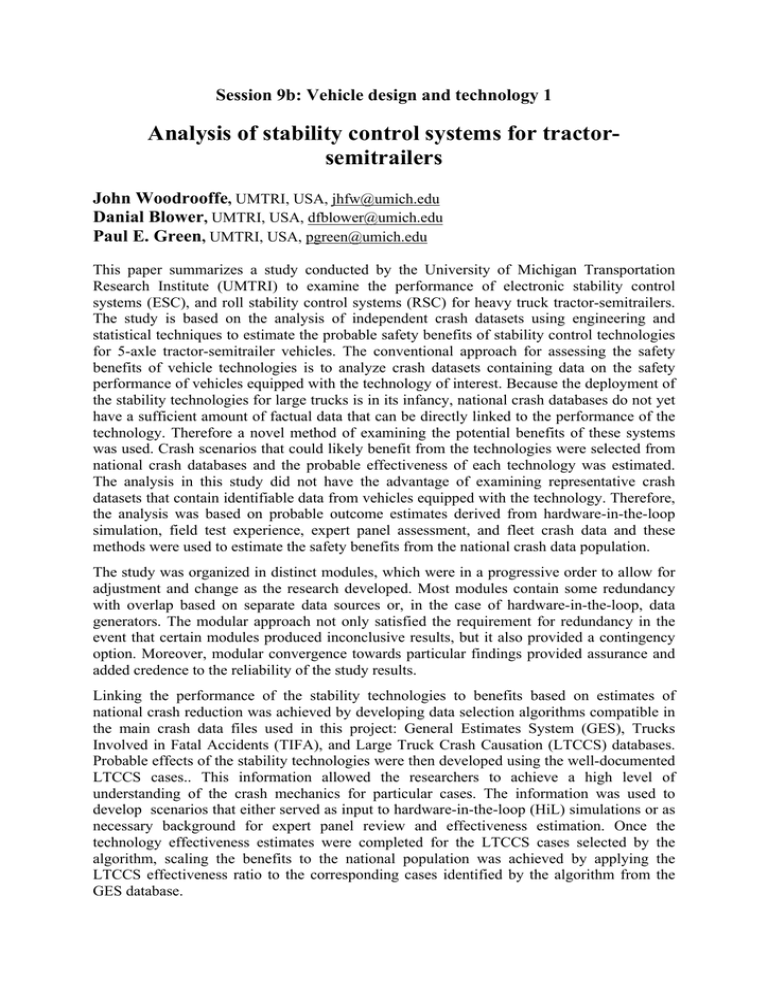Analysis of stability control systems for tractor- semitrailers
advertisement

Session 9b: Vehicle design and technology 1 Analysis of stability control systems for tractorsemitrailers John Woodrooffe, UMTRI, USA, jhfw@umich.edu Danial Blower, UMTRI, USA, dfblower@umich.edu Paul E. Green, UMTRI, USA, pgreen@umich.edu This paper summarizes a study conducted by the University of Michigan Transportation Research Institute (UMTRI) to examine the performance of electronic stability control systems (ESC), and roll stability control systems (RSC) for heavy truck tractor-semitrailers. The study is based on the analysis of independent crash datasets using engineering and statistical techniques to estimate the probable safety benefits of stability control technologies for 5-axle tractor-semitrailer vehicles. The conventional approach for assessing the safety benefits of vehicle technologies is to analyze crash datasets containing data on the safety performance of vehicles equipped with the technology of interest. Because the deployment of the stability technologies for large trucks is in its infancy, national crash databases do not yet have a sufficient amount of factual data that can be directly linked to the performance of the technology. Therefore a novel method of examining the potential benefits of these systems was used. Crash scenarios that could likely benefit from the technologies were selected from national crash databases and the probable effectiveness of each technology was estimated. The analysis in this study did not have the advantage of examining representative crash datasets that contain identifiable data from vehicles equipped with the technology. Therefore, the analysis was based on probable outcome estimates derived from hardware-in-the-loop simulation, field test experience, expert panel assessment, and fleet crash data and these methods were used to estimate the safety benefits from the national crash data population. The study was organized in distinct modules, which were in a progressive order to allow for adjustment and change as the research developed. Most modules contain some redundancy with overlap based on separate data sources or, in the case of hardware-in-the-loop, data generators. The modular approach not only satisfied the requirement for redundancy in the event that certain modules produced inconclusive results, but it also provided a contingency option. Moreover, modular convergence towards particular findings provided assurance and added credence to the reliability of the study results. Linking the performance of the stability technologies to benefits based on estimates of national crash reduction was achieved by developing data selection algorithms compatible in the main crash data files used in this project: General Estimates System (GES), Trucks Involved in Fatal Accidents (TIFA), and Large Truck Crash Causation (LTCCS) databases. Probable effects of the stability technologies were then developed using the well-documented LTCCS cases.. This information allowed the researchers to achieve a high level of understanding of the crash mechanics for particular cases. The information was used to develop scenarios that either served as input to hardware-in-the-loop (HiL) simulations or as necessary background for expert panel review and effectiveness estimation. Once the technology effectiveness estimates were completed for the LTCCS cases selected by the algorithm, scaling the benefits to the national population was achieved by applying the LTCCS effectiveness ratio to the corresponding cases identified by the algorithm from the GES database.

